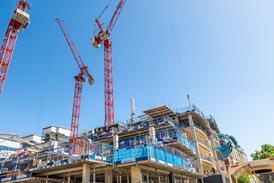Barely a day goes by without some policy announcement on sustainability.
As the evidence on climate change gets ever more alarming, there’s an understandable, and laudable, impulse to rush through ideas to cut greenhouse gas emissions. However, there is a danger that we’ll end up taking a scatter gun to the problem, thereby convincing ourselves that we’re taking effective action when in reality we’re doing nothing of the sort.
This concern is becoming increasingly apparent in our industry, and is reflected in letters to the magazine and comments posted to the “what you think” link on our website. The question of sustainability in general, and the issues of wind power and microgeneration in particular, have generated more debate than any other issue. For our part, we’ve devoted a supplement to the issue (Learning the New Rules, published with this week’s Building). On the website, a proposal by London Eye architect Marks Barfield to install thousands of wind turbines across the capital elicited responses ranging from “it’s a wonderful idea”, to “complete load of cobblers: wind turbines don’t work in urban areas”. That said, it’s infinitely more workable than the idea of installing wind turbines on every suburban rooftop, which most agree would achieve little more than hiking the share price of B&Q.
As Davis Langdon argued in our 30 March issue, the best way to cut emissions is energy reduction, but that doesn’t mean we shouldn’t install renewable generators, too. Each scheme has an optimal, site-specific solution. Biomass boilers fuelled by rice husks may be perfect for the Dongtan eco-city in China, but they’re not going to work for offices in Westminster.
If the industry is going to make sense of these rules, products and aspirations we need to establish some basic principles. Four candidates would be:
• Establish a national framework for the industry to work within. The Code for Sustainable Homes should provide much of this, but it risks being undermined by a plethora of other piecemeal measures imposed by councils. We look forward to seeing what the planning white paper has to say on this.
• We need to find a way to make sure manufacturers’ green products do what they say on the tin. And find people to maintain them.
• We need the utilities to work with housebuilders to set up community energy networks, rather than relying on back-garden generation.
• Someone must provide practical details in the context of a carefully thought through policy. For example, how should the national balance be struck between micro and macro generation? At present the government doesn’t seem to be doing this, a fear borne out by this week’s National Audit Office report. Hopefully we’ll be proved wrong in the forthcoming energy white paper; and there is some reason to hope that Brown’s proposal to combine energy with the environment will turn out to be a very sound idea.
Postscript
Denise Chevin, editor



























No comments yet